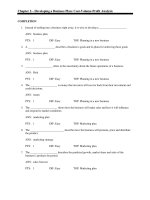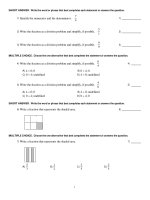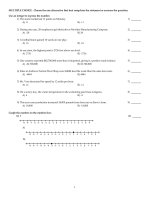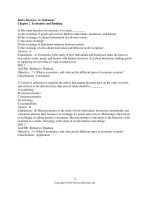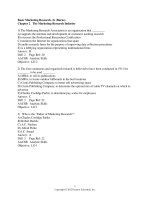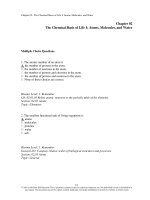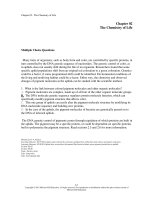Dynamic business law 3rd edition kubasek test bank
Bạn đang xem bản rút gọn của tài liệu. Xem và tải ngay bản đầy đủ của tài liệu tại đây (382.18 KB, 69 trang )
Chapter 02
Business Ethics
True / False Questions
1.
Ethical conversation is primarily about finding the one and only right thing to do.
True
2.
False
Business ethics is the application of ethics to the special problems and opportunities experienced
by business people.
True
3.
False
The social responsibility of business consists only of the expectations employees have of
employers.
True
4.
False
Insurer American International Group (AIG) is well known in the insurance industry for its ethical
and cautious investments protecting investors.
True
5.
False
In some countries, businesses must pay bribes in order to receive legitimate supplies.
True
False
2-1
Copyright © 2015 McGraw-Hill Education. All rights reserved. No reproduction or distribution without the prior written consent of
McGraw-Hill Education.
6.
In an ethical analysis using the WPH Framework referenced in the text, owners are the most
important stakeholders and should receive the greatest consideration in decision making
regardless of the type of problem addressed.
True
7.
The definition of stakeholder is the same as the definition of shareholder.
True
8.
False
The community in which a firm operates would not be considered a stakeholder of the firm.
True
9.
False
False
Situational ethics is the same thing as ethical relativism.
True
False
10. Consequentialism provides a rigid set of rules to follow regardless of the situation.
True
False
11. Utilitarianism is a form of consequentialism.
True
False
12. Ethics is not an issue in accounting because of the primarily objective data involved in that field.
True
False
Multiple Choice Questions
2-2
Copyright © 2015 McGraw-Hill Education. All rights reserved. No reproduction or distribution without the prior written consent of
McGraw-Hill Education.
13. Which of the following was the result in regard to the statute of limitations in the Case Opener in
which the plaintiff claimed that the drug Accutane caused her to develop ulcerative colitis and
irritable bowel syndrome?
A. That because the plaintiff was not warned by her doctor of specific risks caused by the
medication, the statute of limitations did not begin to run until she became aware of an
advertisement discussing the risk.
B. That because the plaintiff was warned by her doctor of specific risks caused by the medication,
the statute of limitations began to run prior to the time she became aware of an advertisement
discussing the risk; and the statute of limitations barred her claim.
C. That the statute of limitations began to run on the plaintiff's claim when the risk of the drug was
discovered by the manufacturer, not on the date on which the plaintiff became aware of the risk
and that the statute of limitations, therefore, barred her claim.
D. That in lawsuits involving this type of drug, there is no statute of limitations because each day
the plaintiff suffers from pain results in the beginning of a new cause of action.
E. That the defendant committed fraud preventing it from relying on the statute of limitations.
14. Which of the following presents a problem when considering the theory of ethics known as
absolutism?
A. The questionable nature of the rules in most absolutist repositories seems overly flexible when
applied to different situations.
B. The unquestionable nature of the rules in most absolutist repositories seems overly inflexible
when applied to different situations.
C. The lack of objectivity.
D. The fact that most individuals associated with this theory have been proven to have acted to the
detriment of their followers in one way or another.
E. The allegation that an excessive number of followers actually follow consequentialism.
2-3
Copyright © 2015 McGraw-Hill Education. All rights reserved. No reproduction or distribution without the prior written consent of
McGraw-Hill Education.
15. Which of the following is the application of ethics to special problems and opportunities
experienced by those in business?
A. Situational ethics
B. Consequentialism
C. Business ethics
D. Sarbanes-Oxley principles
E. Business utilitarianism
16. Which of the following is the study and practice of decisions about what is good, or right?
A. Morals
B. Ethics
C. Consequences
D. Law
E. Business
17. A local Chamber of Commerce plans a seminar on "the social responsibility of business in our
community." What does that term reference?
A. The responsibility of business to make profit for shareholders.
B. The responsibility of business to have annual meetings.
C. The expectations that the community imposes on firms doing business inside its borders.
D. The expectations of employees regarding wage rates.
E. The expectations of management in regard to adequate utility resources.
2-4
Copyright © 2015 McGraw-Hill Education. All rights reserved. No reproduction or distribution without the prior written consent of
McGraw-Hill Education.
18. Which of the following is the minimal standard essential for the development of business ethics?
A. Meeting the requirements of deontology.
B. Meeting the requirement of the public disclosure test.
C. Meeting the requirement of utilitarianism.
D. Satisfying the company's board of directors.
E. The legality of a decision.
19. Which of the following is true regarding business ethics?
A. Business ethics refers to standards of business conduct but does not result in a set of correct
decisions.
B. Business ethics results in a set of correct decisions and does not simply refer to standards of
business conduct.
C. Business ethics produces a list of correct business decisions that all ethical businesses will make
so long as the theory of deontology is followed.
D. Business ethics produces a list of correct business decisions that all ethical businesses will make
so long as the theory of rule utilitarianism is followed.
E. Business ethics produces a list of correct business decisions that all ethical businesses will make
so long as the theory of virtue ethics is followed.
2-5
Copyright © 2015 McGraw-Hill Education. All rights reserved. No reproduction or distribution without the prior written consent of
McGraw-Hill Education.
20. Which of the following was the result in U.S. v. Alfred Caronia, the case in the text in which the
defending pharmaceutical representative was charged with illegally promoting off-label use of a
drug?
A. That the defendant had not indeed promoted off-label use of the drug at issue, and the case
was dismissed.
B. That although the defendant promoted off-label use of the drug at issue, the off-label use was
later approved as a valid and appropriate use, and the case was dismissed.
C. That the defendant's speech failed to meet the criteria for classification as commercial speech
and that, therefore, the defendant had no constitutional argument in opposition to the charges
against him.
D. That although the defendant's speech met the criteria for classification as commercial speech,
no constitutional protection has been historically extended to that type of speech; and the
defendant, therefore, had no constitutional argument in opposition to the charges against him.
E. That although the defendant's speech met the criteria for classification as commercial speech
entitled to constitutional protection under some conditions, the government met the
requirements for regulation of the particular speech at issue involving off-label usage.
21. Which of the following is true regarding revelations involving Enron and WorldCom?
A. That their upholding of high ethical standards in regard to accounting practices supports the
conclusion that the business world should be allowed to regulate itself.
B. That WorldCom, a privately held company, had high ethical standards but that Enron, a publicly
traded company, engaged in illegal accounting practices supporting the conclusion that
privately held companies should be allowed to regulate themselves whereas publicly held
companies need significant government regulation.
C. That WorldCom, a privately held company, engaged in illegal accounting practices but that
Enron, a publicly traded company, had high ethical standards supporting the conclusion that
privately held companies need significant government regulation whereas publicly held
companies should be allowed to regulate themselves.
D. That although illegal accounting practices occurred, it is so difficult to find and regulate such
practices that any regulation should be left to the free market.
E. That accounting issues with these companies illustrate that the business world cannot be
allowed to regulate itself ethically and that government oversight is needed.
2-6
Copyright © 2015 McGraw-Hill Education. All rights reserved. No reproduction or distribution without the prior written consent of
McGraw-Hill Education.
22. Which of the following is asserted by the principle of rights?
A. That whether a business decision is ethical depends on how the decision affects the rights of all
involved.
B. That whether a business decision is ethical depends on how the decision affects the rights of
stockholders without consideration of other stakeholders.
C. That whether a business decision is ethical depends on how the decision affects the rights of
employees without consideration of other stakeholders.
D. That whether a business decision is ethical depends on how the decision affects the overall
economy.
E. That whether a business decision is ethical depends on how the decision affects the rights of
organized labor without consideration of other stakeholders.
23. What is the system of "guanxi" used in China?
A. It refers to a system of relationship building woven together by social ties.
B. It refers to a system of strict ethical rules.
C. It refers to a prohibition against criticism of government rules and regulations.
D. It refers to a system by which business people attempt to avoid strict Chinese regulations.
E. It refers to a system of smuggling.
24. What do the letters "WPH" mean in reference to the "WPH Framework for Business Ethics"
discussed in the text?
A. Who, Purpose, and How
B. When, Plan, and How
C. Why, Procedure, and Hope
D. Where, Plan, and Hope
E. Where, Procedure, and How
2-7
Copyright © 2015 McGraw-Hill Education. All rights reserved. No reproduction or distribution without the prior written consent of
McGraw-Hill Education.
25. Which of the following is true under the WPH process of ethical decision making?
A. The interest of management is ranked higher than that of employees when decisions are made.
B. The interest of owners is ranked higher than that of both employees and management when
decisions are made.
C. When decisions are made, the interest of the community as a whole is considered last.
D. The interest of management is ranked higher than that of employees when decisions are made,
but the interest of owners is ranked higher than the interest of any group.
E. There is not a framework under WPH for ranking one stakeholder above another.
26. Which of the following are stakeholders of a business?
A. Shareholders but not employees
B. Employees but not shareholders
C. Customers but not employees or shareholders
D. Management but not employees
E. Shareholders, employees, customers, and management
2-8
Copyright © 2015 McGraw-Hill Education. All rights reserved. No reproduction or distribution without the prior written consent of
McGraw-Hill Education.
"Environmental Concerns." Connie, the president of a company that makes paper, has a new
interest in the environment. She recently went to a seminar on environmental dangers and has
decided to take steps to clean things up. She started at home and has now felt compelled to
change things at work. Connie had to face the fact that her company has been cheating and is not
in compliance with applicable environmental regulations due to dumping in a nearby river. Her
company has never been cited because it employs a very large number of people in the
community, including the mayor's wife and the chief-of-police's brother. On her mission to clean
things up, Connie has decided to go even further than the law requires and install the very latest
environmental protections. When she announced her plan, the chair of the company's board of
directors, Brooke, had a meeting with Connie. Brooke told Connie to analyze the situation carefully
because the cost of the additional equipment would mean no dividend to shareholders and no
raise for employees. Furthermore, Brooke told Connie that installing all the new equipment would
result in higher prices for the company's paper product and could bankrupt the company because
of foreign competition. Brooke hinted that Connie could be fired if she persisted. Brooke
suggested that Connie just be concerned with a minimal standard of ethics. Connie decides to go
forward with her plan to clean things up under the theory that she wants to treat others in the
same manner that she wants to be treated. Under Connie's theory, if she did not understand the
importance of the environmental improvements, she would want them to be thrust upon her.
27. Which of the following is true regarding meeting the minimal standard of business ethics
suggested by Brooke?
A. Decisions must be legal.
B. Decisions must meet the criteria of a follower of deontology.
C. Decisions must meet the criteria of a follower of utilitarianism.
D. Decisions must receive a majority vote of acceptance by employees.
E. Decisions must be legal and decisions must also receive a majority vote of acceptance by
employees.
2-9
Copyright © 2015 McGraw-Hill Education. All rights reserved. No reproduction or distribution without the prior written consent of
McGraw-Hill Education.
28. Which of the following would be a stakeholder in the above company?
A. The community only
B. The shareholders only
C. Future generations only
D. The community and shareholders only
E. The community, shareholders, and future generations
29. Connie's idea is best referred to as ______.
A. The Golden Rule
B. The Disclosure Principle
C. The Help Peers Test
D. The Sarbanes-Oxley Rule
E. The Greenhouse Rule
30. Positive abstractions that capture our sense of what is good or desirable are called ______.
A. Ethical ideas
B. Values
C. Conscience demands
D. Desirable principles
E. Action goals
31. Which of the following are values in the WPH process of ethical decision making?
A. Freedom only
B. Security only
C. Efficiency only
D. Freedom and security, but not efficiency
E. Freedom, security, and efficiency
2-10
Copyright © 2015 McGraw-Hill Education. All rights reserved. No reproduction or distribution without the prior written consent of
McGraw-Hill Education.
32. The idea that we should interact with other people in a manner consistent with the manner in
which we would like them to interact with us is called the ______.
A. Equalization Rule
B. Ethical Realization Rule
C. Silver Rule
D. Golden Rule
E. Ten Commandments Rule
33. What is the name of the law signed by President Bush in the wake of several corporate accounting
scandals?
A. The Sarbanes-Oxley Act
B. The Public Accounting Act
C. The Certified Public Accounting Act
D. The Whaley-Mallicoat Act
E. The Corporate Scandal Act
2-11
Copyright © 2015 McGraw-Hill Education. All rights reserved. No reproduction or distribution without the prior written consent of
McGraw-Hill Education.
34. Which of the following is true regarding activities of the Public Company Accounting Oversight
Board?
A. The Board ensures that auditors and public accounting firms compile accurate and truthful
financial reports for the companies they audit, but it has no responsibility in regard to whistleblowing protection.
B. The Board requires that companies devise a system that allows employees to report suspicions
of unethical behavior, but it does not address financial reports prepared by auditors and public
accounting firms.
C. The Board requires that the universalization test be used as the primary ethical guideline and
also mandates protection for whistle-blowers who report suspicious activity involving financial
reports.
D. The Board ensure that auditors and public accounting firms compile accurate and truthful
financial reports for the companies they audit and also requires that companies devise a system
that allows employees to report suspicions of unethical behavior.
E. The Public Company Accounting Oversight Board was abolished during the Obama
administration and no longer exists.
35. According to the text, which of the following may be a part of the "how" in the WPH process of
decision making?
A. Public disclosure, universalization, security, and the Golden Rule
B. Values, public disclosure, and security
C. Profit maximization, security, and public disclosure
D. Whistle-blowing, the Golden Rule, values, and public disclosure
E. Public disclosure, universalization, and the Golden Rule
2-12
Copyright © 2015 McGraw-Hill Education. All rights reserved. No reproduction or distribution without the prior written consent of
McGraw-Hill Education.
36. The "public disclosure" test for ethical behavior is sometimes referred to as the ______ test.
A. Television
B. Powell
C. Self-conscious
D. Golden
E. Primary
37. The ______ for ethical behavior seeks consideration of what the world would be like if a decision is
copied by everyone else.
A. Golden rule
B. Universalization test
C. Public disclosure
D. Relevant disclosure
E. World rule
38. Which of the following is true regarding steps taken by news corporations to protect confidential
records?
A. News corporations are putting numerous security barriers and encryptions around their records
so that nobody can gain access to them.
B. News corporations are attempting to protect information written by their own employees, but
efforts are not made to protect confidential sources because constitutional protection does not
extend to confidential sources.
C. News corporations are not bothering with security barriers to the extent as in previous decades
because government regulation requires that information be turned over, and there is no point
in taking drastic measures to protect such information.
D. New regulations make significant privacy barriers illegal in regard to news corporations, so
many barriers have been or are being removed.
E. Because of the respect given to confidential records by the U.S. government and its
enforcement agencies, news corporations see little need to enhance protection of confidential
records.
2-13
Copyright © 2015 McGraw-Hill Education. All rights reserved. No reproduction or distribution without the prior written consent of
McGraw-Hill Education.
"Accounting Advice." Brad, a newly hired Certified Public Accountant, who barely passed his
boards, was asked by a business client, a chief executive officer, about the effect of the SarbanesOxley Act on an accounting issue. Brad assured the client that the client should not be concerned
about the Act because it is very vague, unspecific, and difficult to understand. Brad told the CEO
that in any event, the CEO could not be held personally responsible regardless of what happened
because only company business was involved. Brad also told the CEO that there is no oversight
involved with the act. Later that same day, a coworker of Brad discovered that the CEO had been
involved in misstating some financial reports and had also destroyed financial documents to cover
up fraud. An employee at the company, Laura, had informed the coworker as well as the SEC.
When the issue was mentioned to the CEO, he immediately fired Laura.
39. Which of the following is true regarding Brad's statement that the CEO could not be held liable for
violations of the act?
A. Brad is correct. Under no circumstances can a CEO be held personally responsible for violations
under the act. Any fines would be imposed upon the business entity.
B. Brad is incorrect. The act provides for harsh penalties, and a CEO who knows that the company's
financial reports are incorrect but claims that they are truthful, can be heavily fined. There are no
penalties, however, for destruction of financial documents.
C. Brad is incorrect. The act provides for harsh penalties, and a CEO who destroys or changes
financial documents to mislead can be heavily fined. There are no penalties, however, for
misstatements of a company's financial reports because the company is solely responsible for its
statements.
D. Brad is incorrect, but any fine against a CEO under the act cannot exceed a nominal amount of
$1,000.
E. Brad is incorrect. The act provides for harsh penalties, and a CEO who knows that the company's
financial reports are incorrect but claims that they are truthful, can be heavily fined. Additionally,
a CEO who destroys or changes financial documents to mislead can be heavily fined.
2-14
Copyright © 2015 McGraw-Hill Education. All rights reserved. No reproduction or distribution without the prior written consent of
McGraw-Hill Education.
40. Which of the following is true regarding the Act and Laura's firing?
A. The act does not provide protection for whistle-blowers such as Laura.
B. The act provides protection for whistle-blowers only if it can be shown that a significant amount
of money, in excess of $5,000, was involved in the incident involved.
C. The act provides protection for whistle-blowers only if it can be shown that a significant amount
of money, in excess of $10,000, was involved in the incident involved.
D. The act provides protection for whistle-blowers who work for an accounting firm, but not for
any other employees.
E. Laura's whistle-blowing would be protected under the act, and her firing was illegal.
41. Contrary to Brad's statement, does the Sarbanes-Oxley Act create a board of oversight; and, if so,
what is its name?
A. Brad is correct. No oversight board was created.
B. A board called the Public Company Accounting Oversight Board was created by the Act.
C. A board called the Public Accountability Commission was created by the Act.
D. A board called the CPA Oversight Commission was created by the Act.
E. A board called the Federal Accountability Commission was created by the Act.
42. The ethical theory that requires that we evaluate the morality of an action by imagining ourselves
in the position of the person facing the ethical dilemma is called ______.
A. Situational ethics
B. Ethical relativism
C. Absolutism
D. Consequentialism
E. Relativity ethics
2-15
Copyright © 2015 McGraw-Hill Education. All rights reserved. No reproduction or distribution without the prior written consent of
McGraw-Hill Education.
43. How is absolutism different from ethical relativism and situational ethics?
A. It applies utilitarianism.
B. It holds that a cost-benefit analysis should be applied.
C. It holds that whether an action is moral does not depend on the perspective of the person
facing the ethical dilemma.
D. It applies virtue ethics and concentrates on the accepted values of the person at issue as well as
those of the community involved.
E. It applies corporate ethics principles.
44. Which of the following is true regarding the relationship between ethical relativism and situational
ethics?
A. Like ethical relativism, situational ethics requires that we evaluate the morality of an action by
imagining ourselves in the position of the person facing the ethical dilemma; but unlike ethical
relativism, situational ethics allows us to judge other people's actions.
B. Like ethical relativism, situational ethics requires that we evaluate the morality of an action by
imagining ourselves in the position of the person facing the ethical dilemma and also like ethical
relativism, situational ethics allows us to judge the actions of others.
C. While the two theories are similar, ethical relativism upholds the existence of objective moral
standards whereas situational ethics refuses to recognize the existence of objective moral
standards.
D. Ethical relativism and situational ethics are the same theory.
E. There is no relationship between ethical relativism and situational ethics because the theories
are fundamentally opposed to each other.
2-16
Copyright © 2015 McGraw-Hill Education. All rights reserved. No reproduction or distribution without the prior written consent of
McGraw-Hill Education.
45. Which of the following requires that we see murder as a moral action as long as the murderer
believes that the action is best for himself or herself?
A. Absolutism
B. Deontology
C. Categorical imperative
D. Uncertainty of thought
E. Ethical relativism
46. Which of the following is also referred to as ethical fundamentalism?
A. Ethical relativism
B. Absolutism
C. Social responsibility
D. Ethical absolutism
E. Absolute theory
"Fast Food Dilemma." Richard, who just started at his new job as an assistant manager at a fastfood restaurant, wants to make a good impression. He thinks that things are going great. On only
the second day on the job, however, he sees his boss Jill, the manager, slink out of the restaurant
with a big box of hamburger that she puts in her car. Jill then speeds away. Richard is fairly certain
that Jill did not pay for the hamburger. Richard asks advice of his best friend, Bruce; his girlfriend,
Sally; his sister, Jenny; and his dad, Frank. Bruce says that there are no real objective standards and
that Richard should just decide what is best for him. Sally says that Richard should focus on the
consequences and focus on the greatest benefit to all involved. She believes that it will do no real
harm for Richard to keep his mouth shut because the fast-food restaurant is making plenty of
money and probably does not pay Jill enough anyway. Plus, getting in trouble with Jill could cause
problems at work, and if Richard loses his job, Richard and Sally might have to put off their
marriage. Jenny says that on balance the rule producing the greatest good would be to tell Jill
because stealing does not generally produce the greatest satisfaction. Richard's dad says that as a
matter of principle Richard should tell Jill because stealing is simply wrong.
2-17
Copyright © 2015 McGraw-Hill Education. All rights reserved. No reproduction or distribution without the prior written consent of
McGraw-Hill Education.
47. Which of the following theories most accurately fits the advice given by Bruce?
A. Deontology
B. Act utilitarianism
C. Rule utilitarianism
D. Ethical relativism
E. Virtue ethics
48. Which of the following theories most accurately fits the advice given by Sally?
A. Deontology
B. Act utilitarianism
C. Rule utilitarianism
D. Ethical relativism
E. Virtue ethics
49. Which of the following theories most accurately fits the advice given by Jenny?
A. Deontology
B. Act utilitarianism
C. Rule utilitarianism
D. Ethical relativism
E. Virtue ethics
50. Which of the following theories most accurately fits the advice given by Frank?
A. Deontology
B. Act utilitarianism
C. Rule utilitarianism
D. Ethical relativism
E. Virtue ethics
2-18
Copyright © 2015 McGraw-Hill Education. All rights reserved. No reproduction or distribution without the prior written consent of
McGraw-Hill Education.
51. What is the basis of consequentialism?
A. Deontology
B. Categorical imperatives
C. Inquiry into the consequences
D. Disregard of consequences
E. Act utilitarianism
52. Kantian ethics is involved with which of the following ethical theories?
A. Deontology
B. Act utilitarianism
C. Rule utilitarianism
D. Absolutism
E. Situational ethics
53. An ethical theory that urges managers to take those actions that provide the greatest pleasure
after having subtracted the pain or harm associated with the action in question is called ______.
A. Deontology
B. Utilitarianism
C. Kantian ethics
D. Absolutism
E. Ethical relativism
2-19
Copyright © 2015 McGraw-Hill Education. All rights reserved. No reproduction or distribution without the prior written consent of
McGraw-Hill Education.
54. A business manager who deceives everyone because the manager believes that deception
maximizes pleasure over pain in a given situation is acting consistently with which ethical theory?
A. Act deontology
B. Ethical relativism
C. Act utilitarianism
D. Ethical fundamentalism
E. Rule utilitarianism
55. A business manager may consider it wrong to terminate a person whose spouse has terminal
cancer because a firm has an absolute obligation to support its employees when they are
vulnerable, period. The business manager is acting consistently with which ethical theory?
A. Deontology
B. Ethical relativism
C. Act utilitarianism
D. Ethical fundamentalism
E. Rule utilitarianism
56. A person who believes that they should not cheat on a drug test because if everyone did so, the
drug test would be meaningless is applying a[n] ______.
A. Ethics of care
B. Virtual analysis
C. Cost-benefit analysis
D. Fundamentalist approach
E. Categorical imperative
2-20
Copyright © 2015 McGraw-Hill Education. All rights reserved. No reproduction or distribution without the prior written consent of
McGraw-Hill Education.
57. Which of the following helps explain why the principle of deontology may be difficult to apply?
A. People disagree about what duties we owe to one another and which duties are more
important.
B. People disagree about whether consequences are positive or negative.
C. People disagree about the ethics of care.
D. People disagree about what duties we owe to one another and also whether consequences are
positive or negative.
E. People disagree about what duties we owe to one another, whether consequences are positive
or negative, and about the ethics of care.
58. The ethical system in which the development of virtues, or positive character traits such as
courage, justice, and truthfulness, is the basis for morality is called ______.
A. Absolutism decision
B. Virtual analysis
C. Virtue ethics
D. Fundamentalist approach
E. Categorical imperative
59. Which of the following consists of acting on the basis of the recognition that certain actions are
right or wrong, regardless of their consequences?
A. Act utilitarianism
B. Rule utilitarianism
C. Situational ethics
D. Virtue ethics
E. Deontology
2-21
Copyright © 2015 McGraw-Hill Education. All rights reserved. No reproduction or distribution without the prior written consent of
McGraw-Hill Education.
60. What is a difficulty with the application of virtue ethics?
A. The applicable categorical imperatives.
B. The lack of agreement about the meaning of "the good life."
C. The applicable principle of rights.
D. The ethics of care analysis.
E. The lack of agreement regarding which rules on balance produce the greatest amount of
pleasure for the greatest number of people.
61. The ______ adherents believe that when one individual, the caregiver, meets the needs of one other
person, the cared-for party, the caregiver is helping to meet the needs of all the individuals who
fall within the cared-for party's web of care.
A. Deontology
B. Utilitarianism
C. Absolutism
D. Virtue ethics
E. Ethics of care
62. The ______ holds that the right course of action is the option most consistent with the building and
maintaining of human relationships.
A. Ethics of care
B. Principle of virtue ethics
C. Deontology
D. Act utilitarianism
E. Rule utilitarianism
Essay Questions
2-22
Copyright © 2015 McGraw-Hill Education. All rights reserved. No reproduction or distribution without the prior written consent of
McGraw-Hill Education.
63. Assume you are hired as the president of a new company. Write a code of ethics for the firm.
64. Sally is the president of AAA Components, a company that makes small parts for the automotive
industry. Customers of AAA components are primarily auto manufacturers. Sally's cousin, Frank,
works at the company as a sales representative. A promotion to the sales manager position is
open. Frank has applied and so has Susan, another sales representative. While both Frank and
Susan are good employees, they are skilled in different areas. Susan is excellent with technology
and with placing orders. She does an excellent job in following through with order problems.
Frank, on the other hand, is better with customer relations, and customers seem to like him better.
Sally would like to promote Frank but she has two concerns. Her first concern is that she does not
want it to be perceived that she is being unfair because Frank is family. Her second concern is that
she has a suspicion that some customers are somewhat prejudiced against Susan because she is
female. Most customers with whom the sales representatives deal are male, and Sally suspects that
they may give Frank more consideration than Sally. Define and discuss the WPH framework for
business ethics, and within that framework propose a solution. Be sure to fully address the
populations, purposes, and guidelines included within "W," "P," and "H."
2-23
Copyright © 2015 McGraw-Hill Education. All rights reserved. No reproduction or distribution without the prior written consent of
McGraw-Hill Education.
65. Summarize the following ethical principles:
(a). Ethical relativism
(b). Situational ethics
(c). Consequentialism
(d). Deontology
(e). Virtue ethics
(f). Ethics of care
66. Milly's best friend and roommate, Sarah, is getting ready for a big date. Sarah had her hair and
nails done, bought a new dress, and spent two hours getting ready. Just as Milly sees Sarah's date
coming down the street, Sarah comes out and asks Milly how she looks. Unfortunately, the stylist
did a terrible job, the nails are an odd shade of purple, and the new dress is extremely unflattering.
Sarah has no time to change. Discuss what Milly would say and why under the following principles:
(a). Deontology
(b). Act utilitarianism
(c). Rule utilitarianism
(d). Virtue ethics
2-24
Copyright © 2015 McGraw-Hill Education. All rights reserved. No reproduction or distribution without the prior written consent of
McGraw-Hill Education.
67. What does a reference to the "social responsibility of business" mean? Should businesses consider
community expectations, and why or why not?
2-25
Copyright © 2015 McGraw-Hill Education. All rights reserved. No reproduction or distribution without the prior written consent of
McGraw-Hill Education.
